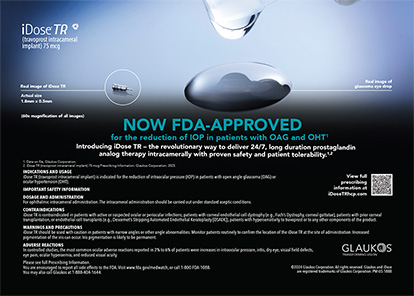Many refractive surgeons shy away from performing PRK due to the procedure's association with late onset of corneal haze in eyes requiring high corrections. Although the prophylactic use of mitomycin C (MMC) has been shown to combat this problem successfully, the potential antifibrotic toxicity warrants caution.
Currently, an optimal dose or exposure time for prophylactic MMC after PRK is unknown. Ronald Krueger, MD, of Cleveland; Marcello Netto, MD, of São Paulo, Brazil; and Ashok Puri, MD, of Jaipur, India, are evaluating low concentrations of MMC (0.002) for prophylaxis. My colleagues and I, meanwhile, are exploring whether short application times of MMC 0.02—a concentration that was originally described for the treatment of existing corneal haze1,2—are equally effective in preventing the post-PRK formation of haze. This article discusses our retrospective study and its results.
STUDY
Objective
Our goal was to determine the optimal duration of exposure of MMC 0.02 to the corneal surface to prevent the development of corneal haze after PRK.
In our initial series, we studied 120 seconds of exposure, which is used therapeutically for existing corneal haze.3 We wanted to gradually lower this time, because the improper use of MMC has resulted in severe consequences, including ocular toxicity, delayed epithelial healing, and corneoscleral necrosis and melt.4,5 We therefore lowered the exposure time to 60 seconds. When we were satisfied that haze was not a significant issue, we reduced the time to 12 seconds (10 of the original exposure time).
Methods
We studied 269 eyes that underwent nomogram-adjusted PRK with applications of MMC 0.02 for 120 seconds (n = 74) versus sequential groups treated with 60- and 12-second (n=36 and 159, respectively) applications. We included patients who underwent planned ablations of at least 75 ?m and were not suitable candidates for LASIK due to low pachymetry readings and/or large pupils. PRK was performed with a number of laser platforms, and a normal postoperative course was followed in terms of pharmacologic management and the use of bandage contact lenses. At the patients' last postoperative visit, we evaluated their amount of corneal haze using a haze grading scale (range, 0 to 4.0) and visual outcomes.
Results
The mean spherical equivalent among the three treatment groups was moderate myopia in patients with relatively thin corneas and deep ablations (Tables 1 and 2). Follow-up ranged from 9 months to approximately 4.5 years. We found no significant difference between the groups in terms of the amount of haze (Table 3). No patient had a haze score greater than 1. Patients' visual outcomes were also quite successful, with most achieving a UCVA of between 20/25 and 20/30 (Table 1).
We found that all of the tested exposure times (120, 60, and 12 seconds) were equally effective against the formation of corneal haze after PRK. Because of the antifibrotic agent's potential toxicity, surgeons should be prudent about the length of each eye's exposure in order to minimize the potential for long-term effects. My colleagues and I now favor a 12-second application of MMC as prophylaxis against corneal haze. For therapeutic purposes, we recommend using MMC 0.02 for 120 seconds.
HOW SAFE IS MMC?
Most issues of potential toxicity associated with MMC relate to pterygium excision, which involves higher concentrations and longer application times than post-PRK prophylaxis.5 Our technique minimizes potential toxicity. We have used this approach for the past 10 years and, to date, have had no patients experience redness or irritation of the eye, delayed re-epithelialization, or corneoscleral melting.
In addition to the retrospective study described herein, my colleagues and I conducted a small pilot study to examine the effects of the drug on the corneal endothelium.6 Sixteen patients underwent PRK with MMC 0.02 applied for 12 seconds. We performed a computed morphometric analysis of the endothelium over a mean follow-up of 18 months. There was no significant difference in the pre- and postoperative endothelial cell densities (Figure 1), the coefficient of variation, or the percentage of hexagonal cells.
The prophylactic administration of MMC 0.02 for haze following PRK did not significantly affect endothelial cell density or morphometric parameters in this study with a mean of 18 months follow-up. We believe that the combination of long-term data and the lack of any evidence indicating endothelial toxicity should give surgeons a higher comfort level when using the agent at this concentration.
Parag A. Majmudar, MD, is Associate Professor of Ophthalmology at Rush University Medical Center in Chicago and is in private practice as a partner with Chicago Cornea Consultants, Ltd. He may be reached at (847) 882-5900; pamajmudar@chicagocornea.com.


